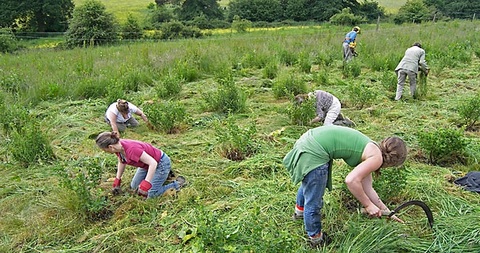by Judith Schwartz on 11 September 2008 in http://features.csmonitor.com
‘Transition initiatives,’ begun in Britain, aim to empower people to tackle effects of climate change and decline of oil.
A year ago, Pat Proulx-Lough felt so overwhelmed by reports about climate change that she couldn’t even listen to the news. “My husband was finishing a dissertation on water resources, and I became hopeless and fearful,” says Ms. Proulx-Lough, a therapist in Portland, Maine.
Fast-forward to summer ’08 and Proulx-Lough is not just hopeful, but excited about the future.
What happened? She tapped into the Transition movement.
Transition Towns (or districts, or islands) designate places where local groups have organized to embrace the challenge of adapting to a low-oil economy. As the movement’s website (www.transitiontowns.org) states, it’s an experiment in grass-roots optimism: Can motivated citizens rouse their neighbors to act in the face of diminished oil resources and climate change?
“ We don’t know if this will work,” says Ben Brangwyn of Totnes, England, who in 2007 helped launch the Transition Network to support Transition Towns worldwide, “but if we leave it to the government it will be too little, too late. If we do it on a personal level, it won’t be enough. But if we do this as a community, it may be just enough, just in time.”
The Transition movement is high-concept and hands-on, combining homespun common sense and camaraderie (bread-baking workshops, “seed-sharing Sundays”) and sophisticated 21st-century organizing (Skype audio conferencing, online wikis, open space technology).
Each Transition “initiative,” as it’s called, begins with a core group willing to serve as a steering committee. In Sandpoint, Idaho, for instance, Richard Kuhnel assembled a group through small discussions at his home. Next comes an action plan and lots of old-fashioned unpaid legwork.
While the concerns – climate change and peak oil (the idea that the world will soon pass its maximum petroleum production and start to decline) – are somber, the approach is upbeat. As the movement’s founder, Rob Hopkins, is fond of saying, “It’s more like a party than a protest march.”
Such ebullience is not typical of ecological realism. According to Michael Brownlee, who was active in the Boulder County, Colo., Transition launch, “the gloom many people feel stems in part from a sense of powerlessness.” The Transition movement advocates no-nonsense routes to local preparedness, rather than waiting for government to step in. “People come in very concerned about climate change, the economy,” Mr. Brownlee says, “but as
they become involved in projects … they rediscover community. Once they feel reconnected to those around them, it changes their whole outlook. The anxiety and depression fall away.”
The movement began, improbably, three years ago with a student project. Mr. Hopkins, a teacher of permaculture – a holistic, ecologically based approach to agriculture, energy usage, and building design – was working with students at the Kinsale (Ireland) Further Education College. They were trying to devise a plan to wean the town off fossil fuels by applying ecological principles on a large scale.
Hopkins brought the model to his home town of Totnes, in southwest England, in 2006, and the idea quickly caught on and spread. Ben Brangwyn was inspired by “Transition Totnes” to leave his job in information technology and devote himself to organizing Transition’s online communication and resources. His hope, he says, is “to encourage every community to proactively prepare for reducing carbon [output] and increasing resilience.”
Rooted in England, sprouting in US
The Transition model still hovers below the radar in the United States. In late July, Ketchum, Idaho, became the third US Transition Town, joining Boulder County, Colo., and Sandpoint, Idaho. (Boulder is holding the first-ever Transition training in the US on Sept. 13 and 14, in fact.) In the UK, where it began, the Transition movement is a cultural phenomenon, with more than 70 Transition Towns in place and many more mulling it over. There’s even a Transition
story line on “The Archers,” Britain’s long-running radio soap opera. In all, worldwide, some 100 communities from Fujino, Japan, to Waiheke Island in New Zealand have met the criteria to claim the Transition mantle.
To Glen Brand, director of the Sierra Club’s national Cool Cities campaign, which promotes clean energy solutions, the Transition movement “provides a fresh perspective for educating the public on local sustainability in an era of looming climate change and depletion of fossil fuels.” The key, he says, is to “make sure that ‘Transition’ means meaningful action with local clean energy and other sustainable solutions.” Aaron
Heurtas, spokesman for the Union of Concerned Scientists, says such local efforts “help to drive all levels of government to take the actions which will be needed to address these issues.”
The goal is not to replace ongoing en viron mental and economic projects. Sand point Mayor Gretchen Hellar says the movement serves to “bring together all groups” working on sustainability, organizing community efforts while not duplicating effort.
A tool kit for responding to warming
Since its founding three years ago, the movement has made “raising awareness” the first step. But, says Jennifer Gray, who spearheaded the effort to launch the second Transition Initiative in Penwith, Cornwall, “We’ve got raised awareness. The climate is changing. Prices are rising…. Transition initiatives are about more than awareness. It’s a tool kit, a template for how to respond, practical projects people can get their teeth
into.”
One item in the Transition tool kit is “reskilling” – reviving energy-frugal skills that past generations took for granted, such as how to repair something rather than buying new and how to grow and preserve food. Says Proulx-Lough, who has spent time in Totnes twice this year: “A workshop on darning socks – that’s practical action, and an excuse to do things together!”
Among other Transition activities:
• Planting nut trees on street corners and orchards in the city.
• Signing up 50 people to buy solar hot-water heaters so the units can be purchased at a discount.
• Interviewing seniors who recall what living a low-energy life was like.
• Holding bicycle-repair workshops
If a Transition Town outwardly looks no different from any other community, it’s because much of the “action” takes place behind the scenes: organizing lectures and films that build awareness; networking with other locations on the Web; meeting with city officials.
Every initiative is different. “It’s all about asking questions of your community and encouraging people to solve their own problems,” says Proulx-Lough. Creative, idiosyncratic responses reflect a town’s culture and history or piggyback on other local programs. Lewes, in East Sussex, a market town for the better part of eight centuries, is poised to launch its own currency. The goal is to stimulate the local economy and help insulate it from
the vagaries of the national and global markets. (The Totnes Pound, accepted in about 60 local shops, has been in circulation for more than a year.)
Some communities, like Totnes and Boulder, with their reputations for alternative lifestyles, might seem natural spots for Transition groups. The same could not be said for Penwith, a high-poverty area at the southwestern tip of Britain. Ms. Gray describes the challenge of persuading a population struggling with day-to-day subsistence to devote time and resources to such an ideal:
“ Penwith is like an island,” Gray says. “People feel insular, and there are high levels of drug addiction and unemployment.” She ran a dairy farm there for several years and now lives in northern California. As a farmer, a parish councilor, and someone with a business background, she could speak to people with diverse backgrounds. “To do this, you need someone who’s a bit of a chameleon,” she says.
While there were plenty of naysayers, Gray did gain community support. “Everybody has a hook,” she says. “You just have to find it. Rising oil prices: They get that hook. Penwith is at the end of the supply chain. If oil goes high enough, people won’t get it here. Therefore it’s important for laying the structure” for a low-carbon future. Ironically, Penwith’s very isolation may mean an easier shift away from oil: “People
in Penwith actually remember what life was like without oil. People made do,” she says.
US size, car dependence are hurdles
The fact that, unlike the UK, most US communities were built around the car is a challenge for the Transition movement in the US. Another is the nation’s sheer size. “It’s difficult to know how best to organize,” says Pamela Gray (Jennifer’s mother), a trustee of the Transition Network, whose focus is building resilience into healthcare systems. Britain has a strong, cohesive media that reaches a broad audience, she notes, whereas in
the US it’s more diffuse.
Still, interest is mounting. “The Transition Movement is about to break on these shores,” Brownlee, the activist from Boulder County, Colo., predicts.
As Portland Mayor Edward Suslovic observes, “financial pain is increasing [people’s] receptivity to sustainability practices in general.” Whether you believe in climate change or peak oil makes no difference, says Sandpoint Mayor Hellar. The sustainable principles embodied in Transition “are not only good for the pocketbook, but good for the community.”
12 key steps toward transition
This is An edited version of a list that appears on the Transition Network’s website (transitiontowns.org/TransitionNetwork/12Steps):
1. Set up a steering group and design its demise. Once a minimum of four subgroups has formed (see Step 5, below), the steering group should disband and reform with a representative from each subgroup.
2. Raise awareness of the potential effects of peak oil and climate change by showing films, holding panel discussions, lectures, etc. Identify your key allies, build networks, “prepare the community … for the launch of your Transition initiative.”
3. Lay the foundation. Network with existing groups and activists. Make it clear that a Transition initiative is designed to incorporate their efforts.
4. Organize a “great unleashing,” a memorable event to mark the project’s coming of age, probably 6 to 12 months after your first conscious-raising event. This builds momentum and “celebrates your community’s desire to take action.” The Unleashing should be “in a spirit of ‘we can do something about this’ rather than doom and gloom.”
5. Form subgroups. Smaller groups should focus on specific aspects, such as food, waste, energy, education, youth, economics, transportation, water, local government, and so on. The question for each: What’s the best way to make the community more resilient and reduce its carbon footprint?
6. Use open space technology for meetings. OST is an organizational strategy with “no agenda, no timetable, no obvious coordinator, and no minute-takers.” (See: “Open Space Technology: A User’s Guide,” by Harrison Owen. More information is available online.)
7. Do things. “Your project needs, from an early stage, to begin to create practical, high visibility manifestations in your community.”
8. Facilitate the “great reskilling.” For society to adjust to a lower-energy future, the thinking goes, people must relearn skills that sustained past generations: repairing, cooking, bicycle maintenance, gardening, etc. They are empowering as well as fun.
9. Build a bridge to local government. “You will not progress too far unless you have cultivated a positive and productive relationship with your local authority.”
10. Honor elders. “To rebuild that picture of a lower-energy society, we have to engage with those who directly remember the transition to the age of Cheap Oil, especially the period between 1930 and 1960.”
11. Let it go where it wants to go. “Your role is not to come up with all the answers, but to act as a catalyst for the community.”
12. Create an “energy descent” plan. “Each subgroup will have been focusing on practical actions to increase community resilience and reduce the carbon footprint.” Combined, these will help create an “energy descent” action plan in response to peak oil and climate change.
|

